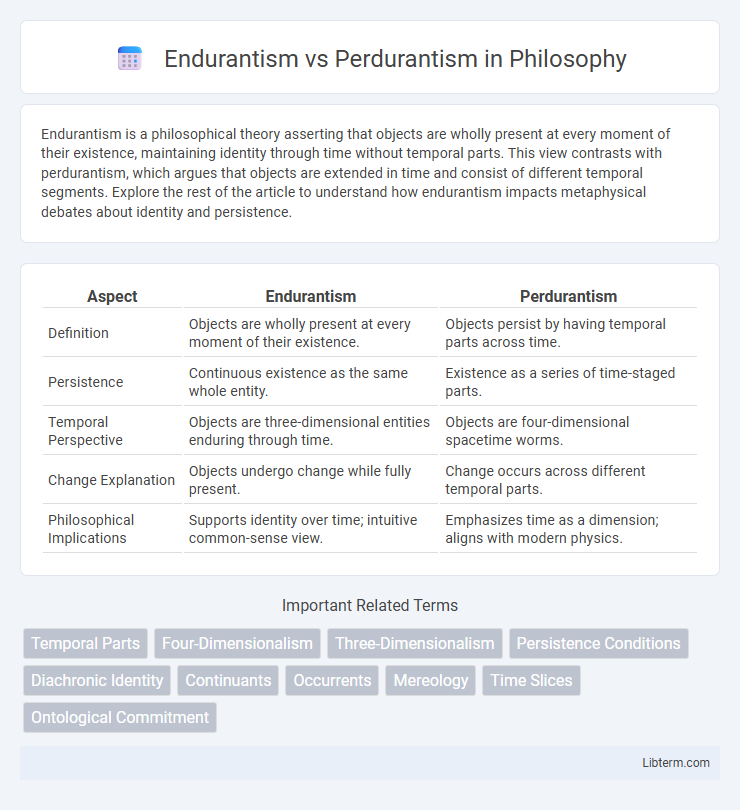Endurantism is a philosophical theory asserting that objects are wholly present at every moment of their existence, maintaining identity through time without temporal parts. This view contrasts with perdurantism, which argues that objects are extended in time and consist of different temporal segments. Explore the rest of the article to understand how endurantism impacts metaphysical debates about identity and persistence.
Table of Comparison
| Aspect | Endurantism | Perdurantism |
|---|---|---|
| Definition | Objects are wholly present at every moment of their existence. | Objects persist by having temporal parts across time. |
| Persistence | Continuous existence as the same whole entity. | Existence as a series of time-staged parts. |
| Temporal Perspective | Objects are three-dimensional entities enduring through time. | Objects are four-dimensional spacetime worms. |
| Change Explanation | Objects undergo change while fully present. | Change occurs across different temporal parts. |
| Philosophical Implications | Supports identity over time; intuitive common-sense view. | Emphasizes time as a dimension; aligns with modern physics. |
Introduction to Endurantism and Perdurantism
Endurantism and perdurantism are two primary metaphysical theories addressing persistence and identity over time. Endurantism posits that objects are wholly present at every moment of their existence, maintaining their identity by enduring through time without temporal parts. Perdurantism, in contrast, views objects as four-dimensional entities extended in time, composed of temporal parts that represent the object's various stages across its lifespan.
Defining Endurantism: The Theory of Wholly Present Objects
Endurantism is a metaphysical theory positing that objects are wholly present at every moment of their existence, maintaining their complete identity through time. This view contrasts with perdurantism by rejecting temporal parts and instead affirming that objects persist by enduring as entire entities. Endurantism supports intuitive notions of persistence, grounding debates in ontology, identity, and the philosophy of time.
Understanding Perdurantism: Objects Through Time
Perdurantism conceptualizes objects as four-dimensional entities extended across time, consisting of temporal parts or stages that together form the complete object. This perspective allows for a dynamic understanding of identity, where objects persist by having different temporal parts at different times rather than being wholly present at each moment. The theory supports a more nuanced approach to change and persistence, accurately reflecting the complexities of temporal existence in metaphysics.
Historical Background and Philosophical Roots
Endurantism and perdurantism emerged from longstanding debates in metaphysics concerning the nature of identity and persistence over time. Endurantism, with roots tracing back to Aristotle's notion of substances persisting wholly through time, views objects as wholly present at each moment of their existence. Perdurantism, influenced by the four-dimensionalist perspective developed during the 20th century, conceives objects as extended entities composed of temporal parts or stages, a view prominently associated with philosophers like David Lewis and Theodore Sider.
Key Differences Between Endurantism and Perdurantism
Endurantism posits that objects are wholly present at every moment of their existence, maintaining identity through time, whereas Perdurantism views objects as extended entities composed of temporal parts spread across time. The key difference lies in how persistence is understood: Endurantism supports three-dimensionalism with complete temporal presence, while Perdurantism embraces four-dimensionalism, emphasizing temporal segments. This distinction impacts debates in metaphysics on identity, change, and persistence across time.
Major Arguments Supporting Endurantism
Endurantism is supported by the argument that objects are wholly present at every moment of their existence, preserving identity over time without fragmentation. This view aligns with common-sense intuition and everyday experience, where objects maintain continuous, unified existence despite temporal changes. Endurantism also addresses the problem of temporary intrinsics by positing that objects possess properties wholly at each time, avoiding the complications associated with perdurantist temporal parts.
Core Arguments Advocating Perdurantism
Perdurantism argues that objects persist by having temporal parts, allowing for a comprehensive explanation of change and identity over time. This view resolves the problem of temporary intrinsics by positing that properties are time-indexed, avoiding contradictions inherent in endurantism's assumption of wholly present objects at each moment. Perdurantism also offers a superior framework for explaining diachronic identity through the four-dimensional ontology, aligning with contemporary physics and metaphysics.
Implications for Persistence and Identity Over Time
Endurantism posits that objects are wholly present at every moment of their existence, maintaining identity through continuous self-sameness, which impacts the way persistence is understood as unchanging presence. Perdurantism, by contrast, views objects as four-dimensional entities extended in time, composed of temporal parts, leading to an identity conception grounded in diachronic relations among these segments. This distinction influences philosophical debates on identity persistence, causality, and change, affecting theories in metaphysics and the philosophy of time.
Contemporary Debates and Notable Philosophers
Contemporary debates on Endurantism versus Perdurantism center on the metaphysical understanding of persistence, with Endurantism positing that objects are wholly present at each moment, while Perdurantism argues that objects are extended across time as temporal parts. Notable philosophers such as David Lewis advocate for Perdurantism through his four-dimensionalist framework, whereas Michael Loux and Sydney Shoemaker support Endurantist perspectives emphasizing enduring entities. Current discussions also address the challenges of temporary intrinsics and the problem of change, highlighting the interplay between temporal ontology and identity conditions.
Conclusion: The Future of Persistence Theories
Endurantism and perdurantism offer contrasting frameworks for understanding persistence through time, with endurantism emphasizing wholly present entities and perdurantism focusing on temporal parts. The future of persistence theories lies in integrating metaphysical insights with advancements in physics and cognitive science to better explain identity over time. Ongoing research aims to refine these theories by addressing challenges such as temporal parthood and the nature of change, promoting a more comprehensive account of persistence.
Endurantism Infographic

 libterm.com
libterm.com